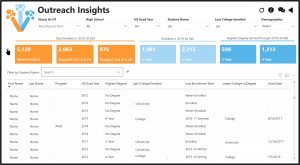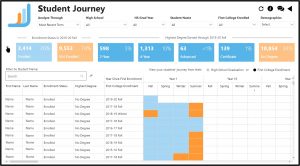
Published: November 9, 2021
How Postsecondary Data Can Drive Action to Support Students
From college preparation to completion, every student’s college journey is unique. But the lack of uniformity in experience also comes with different challenges.
Systemic inequalities deeply rooted within institutional systems continue to serve as barriers to student success, especially for marginalized students. According to the National College Attainment Network, “Students from low-income backgrounds are only half as likely to complete a postsecondary certificate or degree by age 26 as high-income students. Moreover students of color and those who are the first in their family to attend college experience disproportionately lower rates of postsecondary success.”
With the power of educational big data and technology combined, schools, districts, and organizations have the ability to identify trends in educational equity gaps in order to improve college access and success. In particular, those directly serving students can easily evaluate student data to see which groups of students are in need of outreach and support.
Using GuidEd Insight to support students
GuidEd Insight provides administrators and advisors across the nation the data and insights they need to begin closing equity gaps and increase college access and success for each of their students.
The Outreach Insights report helps staff quickly identify which students need what types of support, whether the student never enrolled, stopped out, is currently enrolled or already graduated. Paired with the Student Journey report that allows users to follow each student’s term-by-term college enrollment, users have the ability to work towards the following:
Prevent summer melt
Many high school graduates show the interest of applying to college, but between the time they graduate and get ready to attend college, a number of barriers and the lack of support can make it challenging for the students to go through with the college process. This is a phenomenon commonly referred to as “summer melt” that affects up to 40 percent of students, especially those from low-income backgrounds.
Proactive outreach and support for students early on is important in preventing summer melt. With the data visualized by GuidEd Insight’s Outreach Insights, staff who are in direct student-serving roles can easily identify a particular group of students and offer support where it is needed. This data set allows for staff to find answers to questions like “Among those who said they were going to college, who didn’t enroll?”. Understanding what supports helped which groups of students avoid summer melt can help staff work towards easing the postsecondary transitions for future students.
Support students by providing support services and programming
Outreach efforts can also create an opportunity for staff to determine what type of support students may be needing. Utilizing the insights from the Student Journey report can facilitate the conversations between high schools, colleges, and community partners to determine how well students can be and are being supported.
Recognizing that the responsibility of student success does not fall into the hands of schools alone, partnerships among schools, colleges, and community-based organizations are extremely valuable in identifying areas of need for students. This allows school or program staff to provide timely support services based on specified initiatives including FAFSA completion, scholarship or college application assistance, and summer bridge programs. Other support programs and efforts offered to students may include things like pairing a high school student with a college graduate who had similar interests or offering specific support services to a particular group of students. Staff might also explore the option of engaging in improved practices and strategies for postsecondary advising to increase successful transitions and motivate college persistence and completion outcomes.
Follow persistence and completion outcomes
Oftentimes high school advisors have no idea what happens to students after they graduate from high school beyond a handful of students who may keep in touch. Being able to follow a student’s journey to and throughout college is crucial. The level of insight provided by these reports can also help to determine which group of students are persisting through and completing their college degrees. From there, you have the potential to notice certain trends and patterns leading to the opportunity to close equity gaps and improve postsecondary outcomes for every student.
Close equity and opportunity gaps
At its core, the GuidEd Insight tool is designed to make complex postsecondary data easy to understand so that advisors, educators, and administrators can identify the trends and patterns facing marginalized students, such as students of color, first-generation students, and students impacted by poverty.
In using students’ college enrollment statuses, staff can identify who to reach out to and what general kinds of support they may need, thus having the ability to provide tailored support to students. This brings you one step closer to closing equity gaps and ensuring that more students enroll, persist, and graduate from college.
To learn more about the GuidEd Insight tool, access our demo here: https://www.guidedinsight.org/access-demo/


